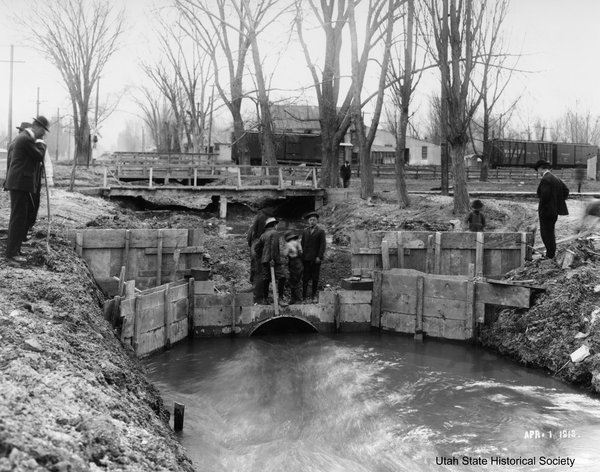Dublin Core
Title
Description
Booming business and population growth in the late 1800s stressed Salt Lake City’s canal infrastructure and polluted its limited water supply. Hoping to clean up and curb the growing cases of waterborne illness that were plaguing residents, city planners designed a sewage system for the city. Most public health reforms benefited the affluent, white neighborhoods of Salt Lake, while neglecting sanitation needs in the economically and racially diverse Westside neighborhoods. This left the Westside stereotyped as dirty and dangerous, and it was the last area to receive sanitation improvements and access to clean water.
Salt Lake City’s Pioneer Park neighborhood was already at a geographic disadvantage. Sitting along the floodplain of the Jordan River, runoff and unused water from nearby suburbs flowed down and through Pioneer Park. Large, open canals that were meant to reduce spring flooding ultimately became open sewers filled with litter and industrial runoff, as well as animal and human waste. The Westside’s growing industry and many train depots contributed to the pollution found in the canals, and the area suffered more than its share of waterborne illnesses, including typhoid and diphtheria.
In 1890, Salt Lake City raised $70,000 dollars to meet demands for sanitation reform with plans for a municipal sewer. Brick-lined pipes carried waste down Main Street, turned west to the Jordan River Surplus Canal, and eventually emptied into Great Salt Lake. However, these downtown improvements were unequal and favored wealthier neighborhoods. The new system required immediate improvements, which put the Westside’s plan for a sewer system on hold. City leaders eventually cleaned up the Pioneer Park neighborhood in order to preserve the city’s first settlement location, but it was 1923 before most of the city had sewer service.
Damage to the Westside’s reputation remained. For wealthier neighborhoods, sanitation services were a public health concern, but for the Westside, the issue was depicted as one of individual failing. The neighborhood’s residents – often poor whites and recent immigrants – shouldered the blame for their “unsanitary” neighborhood. Despite improving public health standards and modern plumbing, these stereotypes about Salt Lake’s Westside persist to this day.
Creator
Source
_______________
See Brad Westwood,“Salt Lake City Loses its “Dirtiest City” Status, the West Side, Public Health, and the City’s only Surviving Pioneer Square,” Salt Lake West Side Stories: Post 14, Utah Department of Cultural and Community Engagement, no date; Brad Westwood and Cassandra Clark, “The Progressive Era, the Making of a Proper Park, and the ‘Stockades’,” Salt Lake West Side Stories: Post 15, Utah Department of Cultural and Community Engagement, no date; Ben Cater, “Segregating Sanitation in Salt Lake City, 1870 - 1915,” Utah Historical Quarterly, vol. 82, no. 2, 2014, pp. 92-113; Leroy Hooton,”Salt Lake City’s Wastewater Collection and Treatment Program,” SLC Docs, no date.

